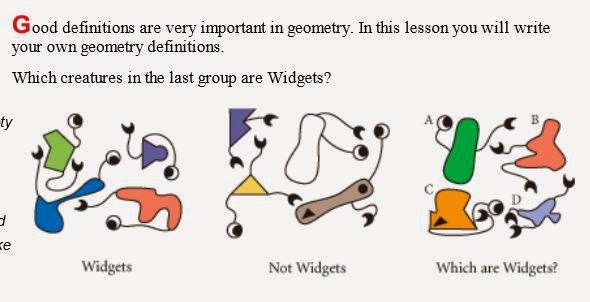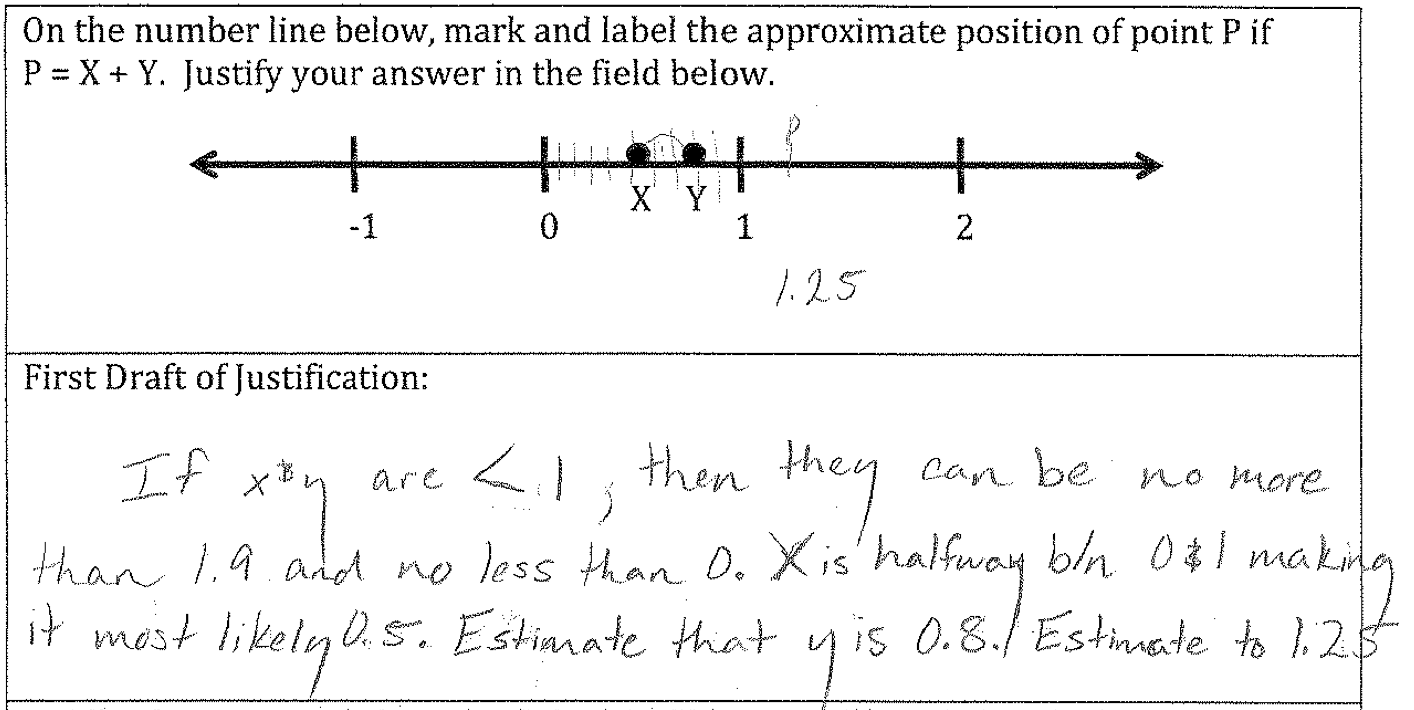What is a Widget?
My colleague and friend Amy Zimmer (http://zicker63.blogspot.com) shared an image with me at the beginning of the year that comes from the Discovering Geometry textbook (see below). The goal is for students to develop a definition of a Widget based on the pictures provided.
I displayed the picture on the board and asked students to quietly observe what they thought a Widget might be. I asked them to be mindful of the characteristics that they were looking for to establish their definition. After a minute of solo think time, I had students turn and talk to a partner about what they were noticing and what their initial ideas were for what it meant to be a Widget. I called on a few students to share the characteristics they were considering, not to share their definition just yet (see list below).
Once the class agreed that we had listed all of the characteristics that were important, or even ones that didn't end up being relevant, we started to use those to refine our definition. I had students turn and talk to their partner again to formalize their definition and I asked them to share it out with the rest of the class. I wrote notes on the board and our definition was born.
Once we had our definition, we tested it on the "Widgets" and "Not Widgets" from the picture to make sure it held true and that we had not overlooked anything. The last step of the process was to see which of the four images (A, B, C, and D) were Widgets. Without having to ask, students were able to say Yes or No and provide a reason why. I asked, "Is A a Widget?" and students responded with, "Yes, by our definition, A is a Widget." When I asked, "Is B a Widget?" students said, "No, because it does not have exactly one eye and one claw." It was obvious that they actually appreciated the concrete set of rules that they had developed in defending their answer.
In two of my classes, the rule about the eye and claw was not immediately as precise as "Exactly one eye and one claw". Students had said something about they had to have eyes and claws. When we looked at picture B, it required us to go back and revise our definition, which was so wonderful to show them that our first draft did not need to be our final draft.
It is my guess that for most students, this kind of abstract reasoning is not happening very often. When students think about definitions, they probably think about their English class and having to look up words in a dictionary. I wanted to show them that using definitions is an acceptable way to build an argument and that those definitions and arguments could be even stronger if they were given the chance to build them based on their own understanding.
Bongard Problems
Dr. Patrick Callahan (Co-Director of the California Math Project) had shown me these problems a while ago and I was recently re-inspired when I saw him share them with a group of teachers in Fresno during a professional development session. Here is a slide from Dr. Callahan's Power Point:
A Bongard Problem is a collection of 12 images where the 6 on the left hand side all share a characteristic (or characteristics), and that characteristic is not present in any of the 6 images on the right hand side. The task for the reader (or student in my case) is to determine a rule that works for all images on the left, and none on the right. Here is an example (also taken from Dr. Callahan's PPT):
Here's what I love about this particular problem (it's #4 on the website) -- students might not know the words concave or convex, but what so many of them pick up on is that the images on the right hand side are all "sunken in", or "have a bend in them", or even that they have a "part missing". They notice that all of the images on the left hand side are "pushed out" or have "nothing missing". This is exciting because it's an opportunity to build on what they already know and can observe about a figure to then introduce the more formal term for these ideas (concave and convex).
When I first introduced these to my students, I shared these two, along with some others that were more challenging. What I found interesting was that there wasn't a sense that I was the one who held the answer. Students had already picked up on the fact that they could check to see if their rule held true just by looking at the images on the left and the images on the right. I know that some teachers struggle with the idea of not being the authority in the classroom in terms of knowledge, or having the answer, but this happened so naturally that I actually addressed it with my students. I wanted them to acknowledge that they had the skills to be able to answer the question "Does that work?" or "Is that right?" They learned very quickly that the responsibility of coming up with a rule fell on them, not on me.
For homework that night, I had students create their very own Bongard Problem. I wanted to see what they would come up with and how creative they would be. These are some of my favorites. Which ones can you figure out the rule for?
I wanted to continue with this work because I feel that the use of definitions is something that we can rely on throughout the school year. But, I wanted to formalize it and see if I could help students organize their thoughts with a template or structure that allowed them to articulate their thoughts more clearly. This is what I came up with:
When I introduced the template, it was clear that students were a little apprehensive to write anything down because it seemed so final. But with some practice, they realized that it was a work in progress and that they could take the risk of not having it perfectly stated the first time.
I asked a random student to pick a number between 1 and 100 (the number of problems that Bongard wrote) and in my first period class, the chosen student selected 94. So, we looked at Bongard Problem #94:
This ended up being a great one to address precision of language. Students realized that a subtle difference in wording could actually mean something that they did not intend to say. With the template, students were given individual think time to develop their own rule and write ideas down, then they could turn and talk to a partner to refine their rule and perhaps see things they had not initially observed. After about 2 minutes, I selected a group at random to share their rule with the class. I gave them one minute to come to consensus as to what I would write on the board. Once I had their first draft of a rule written on the board, it was the job of the rest of the class to brainstorm feedback or clarifying questions for this particular group. It was not an opportunity for a new group to share the rule that they come up with for us to compare. I said that we were committed to helping this particular group come up with the best version of their rule as we could.
Students provided feedback on things that surrounded the precision of language. They referenced the actual picture to defend why they thought their feedback was important. If the first draft of the rule said "The black dot is not at the end of the string of dots", students might ask for more specifics of the black dot's location in regards to the white dots. Or, if the first draft said "The black dot is between 2 white dots", students might ask about the image on the left hand side that is on the right in the middle row. This elicited more precision of language such as "between at least white dots", etc.
Here are some student work samples of how they worked through the process of writing a rule:
We did five of these Bongard Problems as a class over the course of about 3 weeks. I would start class with them, almost like a warm-up. I especially like how this practice went along with the first unit in our textbook, which is very heavy with new terminology and vocabulary. It was nice to have an example separate from the textbook to use that showed the importance of developing a definition to build an argument. I am excited to see where this takes us in our next unit on transformations!
Lastly, I wanted to share some pictures from the last Bongard Problem that we did as a class. These come from the three sections of Geometry that I teach, and I wanted to capture the original rule and the result of giving feedback and modeling revision that I used with my students.
The Bongard Problem was #58:
And here is how students developed their rule:
I would encourage teachers to use Bongard Problems in their classes to help students build a foundation for using definitions and understanding the importance of precision of language. There are some Bongard Problems that are quite challenging, but for the most part, I have found that students enjoy the puzzle element of finding the rule and are willing to take the risk of being wrong the first time. I have seen growth in their reasoning skills and I am encouraged by their perseverance and overall willingness to try and work hard.


















































